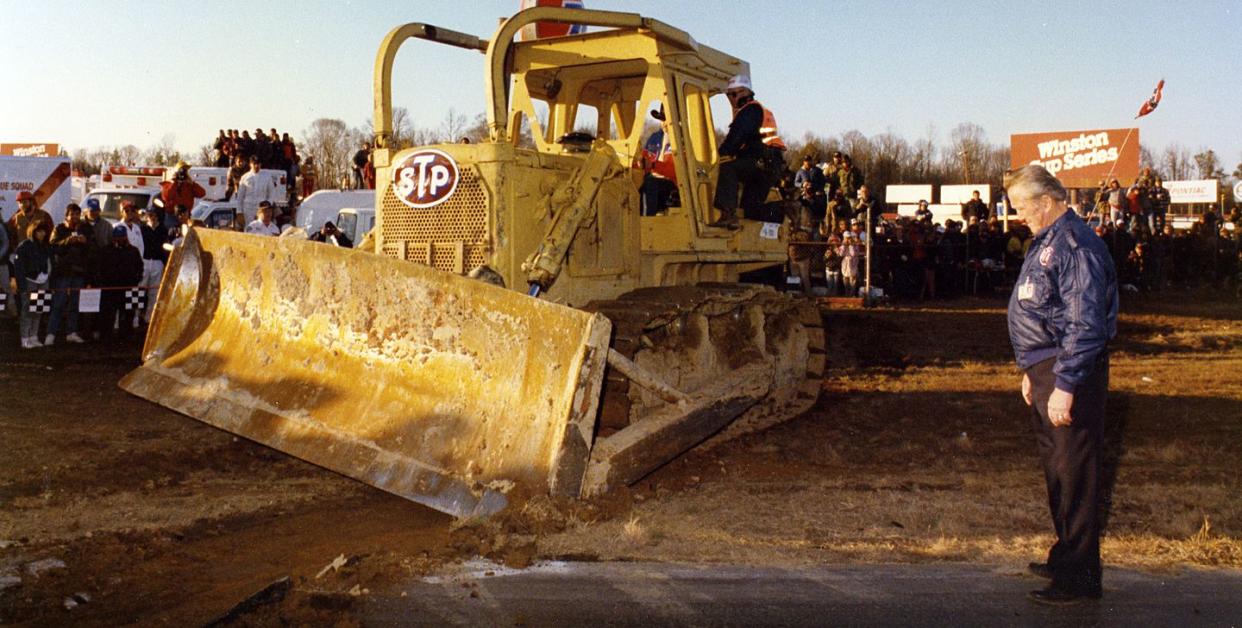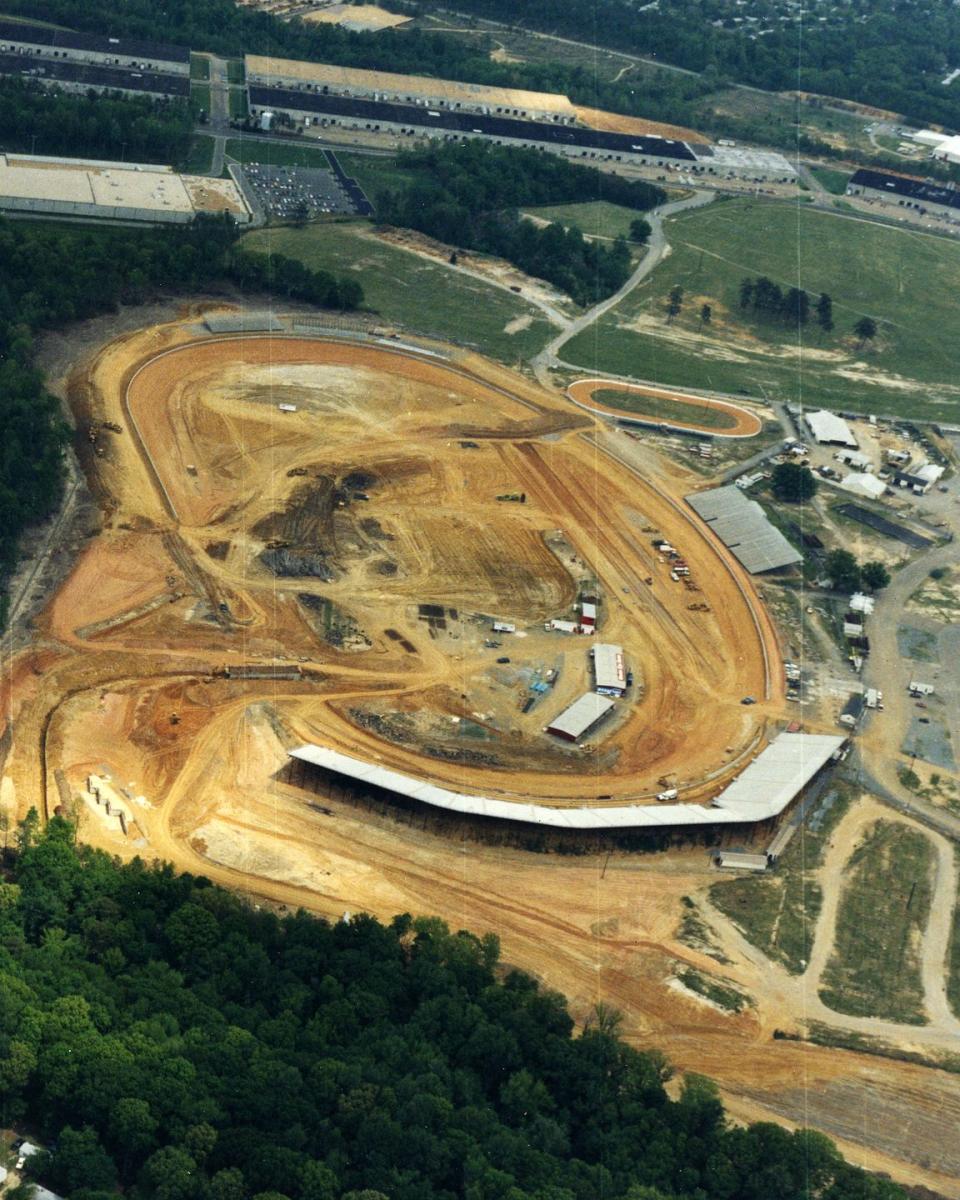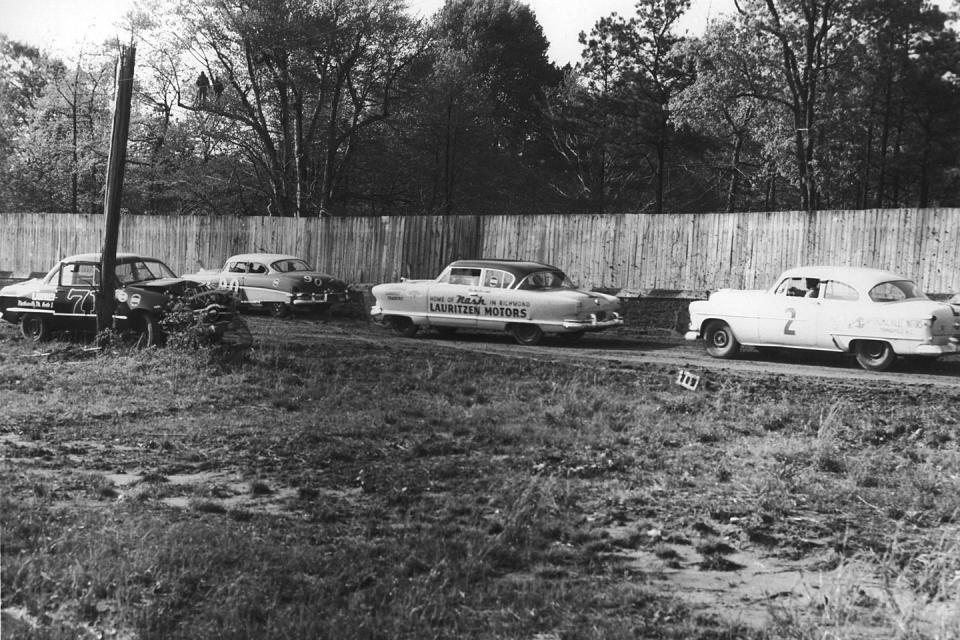How Richmond Raceway's 1988 Rebuild Was Nothing Short of a NASCAR Miracle

- Oops!Something went wrong.Please try again later.
- Oops!Something went wrong.Please try again later.
- Oops!Something went wrong.Please try again later.
- Oops!Something went wrong.Please try again later.
It’s been almost 35 years, but Billy Sawyer still grins as he recounts NASCAR president Bill France’s visit to Richmond Raceway in June of 1988.
At the time, track owner Paul Sawyer and his sons, Billy and Wayne, were busy tearing down their antiquated, half-mile oval and building a spanking-new, ¾-mile, D-shaped facility atop the same footprint.
France, who had worked with the family for decades, was worried that the new facility wouldn’t be ready for its scheduled 400-lap, 300-mile race the weekend after Labor Day. France had flown up from Daytona Beach to check out things.
The tour went something like this:
“Daddy’s driving Bill France around the property, showing him where everything was going to be,” Billy Sawyer recalls. “Bill looked over at Daddy and says, ‘Paul, maybe you should call Enoch Staley (at North Wilkesboro Speedway) or Clay Earles (at Martinsville Speedway) and talk about trading one of their (fall) dates. You run your race at one of their tracks the weekend after Labor Day, then let them come here later in the fall, when this place is ready. There’s no way you’re gonna be done here by September.”

Billy Sawyer remembers that his father gently reminded his visitor that he (France) had been talking for almost two years about building a lavish tower overlooking Daytona International Speedway, but still hadn’t turned any dirt. “Daddy said, ‘Don’t worry about us, Bill. We’ll be ready in September.’ ”
And, of course, they were. This weekend’s Toyota Owners 400 will be the 70th NASCAR Cup Series race at the Laburnum Avenue site since Sept. 11, 1988, when Davey Allison won the Miller High Life 400 for team owner Harry Ranier. This weekend’s schedule includes a Whelen Modified Tour 150 at 6:30 p.m. on Friday, an Xfinity Series 250 at 1:30 p.m. on Saturday, and the Cup Series 400 at 3:30 p.m. on Sunday.
In one of the most impressive facelifts in recent sports history, the Sawyers first tore down several sections of the 35,000-seat grandstand at the State Fairgrounds Raceway. Their team then razed the scoring and timing booths, the infield and grandstand media centers, their office complex, the Armco and chain-link retaining barriers, pit road, and the half-mile of worn-out black asphalt itself. Once that was done, crews arrived and began building the new ¾-mile track from scratch.

Work unofficially began around sunset on Sunday, Feb. 21, 1988, shortly after Neil Bonnett won the Pontiac Excitement 400 for team owners Bob Rahilly and Butch Mock. In the No. 75 Pontiac, the popular Alabama driver beat Ricky Rudd, Richard Petty, Darrell Waltrip, Sterling Marlin, Lake Speed, and Rusty Wallace, the only other drivers on the lead lap. It was the 62nd Cup Series race on the property, which had started hosting NASCAR on its half-mile dirt and asphalt surfaces in 1953.
Shortly after the race—with fans still hanging around—Petty, a 13-time Richmond winner, climbed aboard a yellow Caterpillar and began gouging up chunks of the Turn 4 asphalt (pictured in the driver's seat, above). “We wanted fans to know how serious we were about rebuilding,” Bill Sawyer says, “so who better than the King to start tearing down the place. We had 199 days to get it done.”

France’s concern that Richmond might not be ready for its fall race weekend was shared by others … but never the Sawyers. “We were out there seven days a week, 14-to-16 hours a day,” Billy says. “It took a toll on all of us, but at the end of the day we’d always say, ‘Hey, look what we did today.’ All of a sudden, when it became obvious that we’d be ready for racing in September, the naysayers got very quiet. It wasn’t necessarily the prettiest race track that opening day, but it was functional and we raced on it.
“We had planned it so carefully and had everything in line so we knew we could do it. There was a surprise or two along way, but nothing big enough to throw us off schedule. We got a lot of help from a lot of people who knew how important it was to us. As a family, we were—and still am—proud of what we did.” (Paul Sawyer died in 2005 at 88; his eldest son, Wayne, died in 2021 at 78; Billy Sawyer now runs Virginia Motor Speedway, a half-mile dirt track near Saluda, Va.)
Ricky Rudd, a 1984 winner on the half-mile and a 2001 winner on the new track, hated to see the old track go. “It was tricky, harder to get around than the new one,” he said. “It was flat and would get slippery, and I missed it. Converting to the three-quarter-mile was an ambitious project, but I never really doubted they’d get it done.”
Brett Bodine watched the rebuild with mixed emotions. He appreciated the old track’s history, but also knew NASCAR was nearing a time when aging half-milers would be obsolete. “That place held so much history and tradition,” he said. “Just think of the drivers who had raced there throughout the history of NASCAR. All the great ones had been there. But if the sport was going to grow, Richmond needed a new facility. And the Sawyers built a perfect three-quarter-mile. From almost every perspective, it couldn’t have been any better.”
Current fans may be surprised to know the first races at what is now known as Richmond Raceway were for Indy-style “Champ Cars” shortly after World War II. The state-run Atlantic Rural Exposition had built a half-mile dirt track suitable for thoroughbreds and cars. Ted Horn, in an open-wheel Indycar, won its first race in the fall of 1946, before NASCAR was even created.

The track’s first Cup race was in April of 1953, when Lee Petty won a 200-lap event on the half-mile dirt. (Much later, his son, Richard, and grandson, Kyle also won in Richmond). The original track was paved in 1968, but remained a basic half-mile oval until the rebuild between the 1988 races.
Through the years Richmond has hosted almost every series: NASCAR Cup, Xfinity, Truck, Modified, Goody’s Dash, Sportsman, Grand American, Convertible, and K&N. The Indy Racing League and IROC once raced there, as well as Midgets, Silver Crown, and Sprint Cars, and USAC stock cars.
In 1992, after owning the facility since 1955, Paul Sawyer sold the track to International Speedway Corp. for a reported $215 million. “We had done what we set out to do,” Billy Sawyer says wistfully. “It was time to do something else.”


